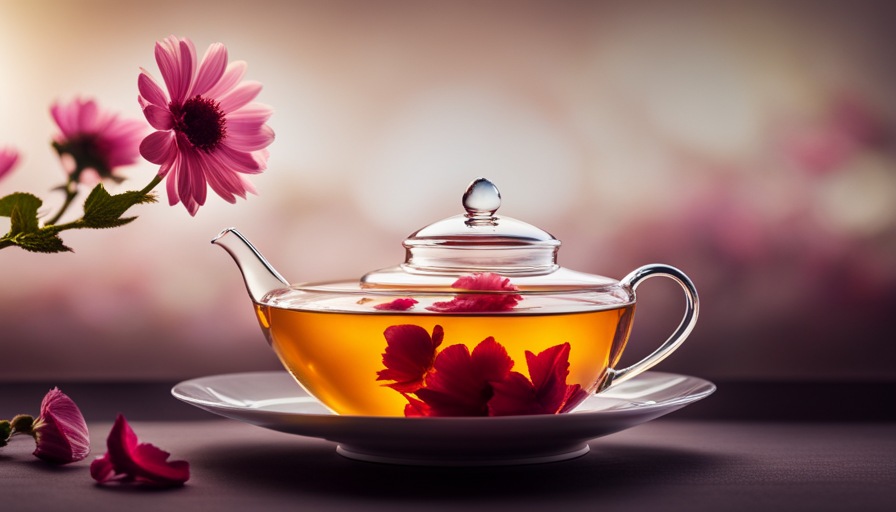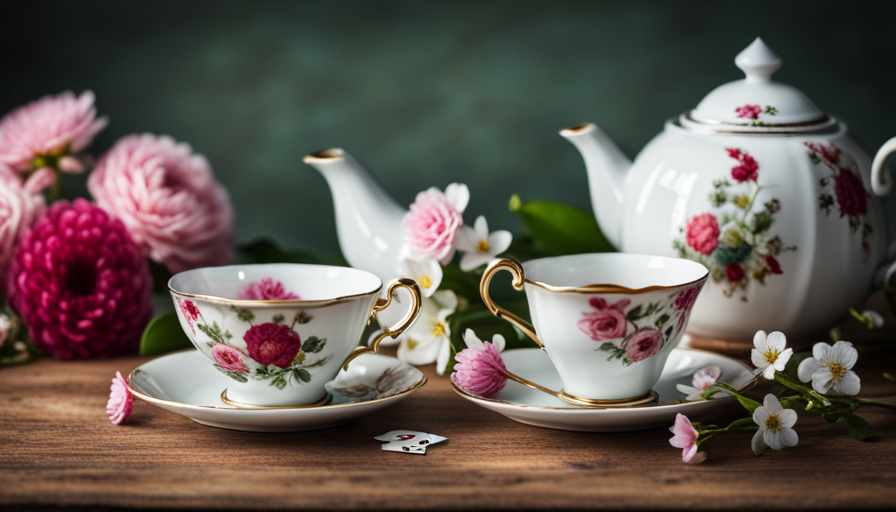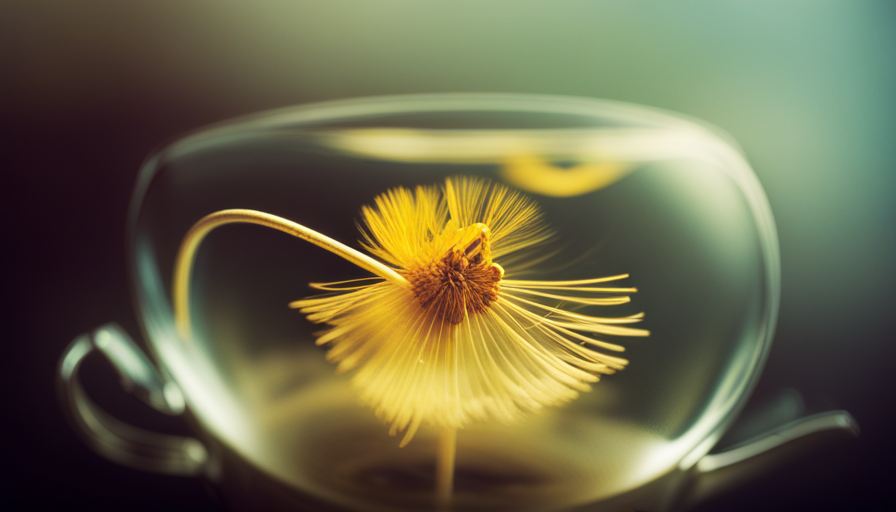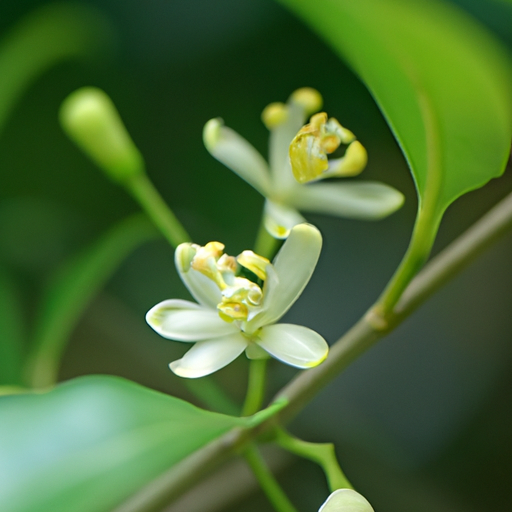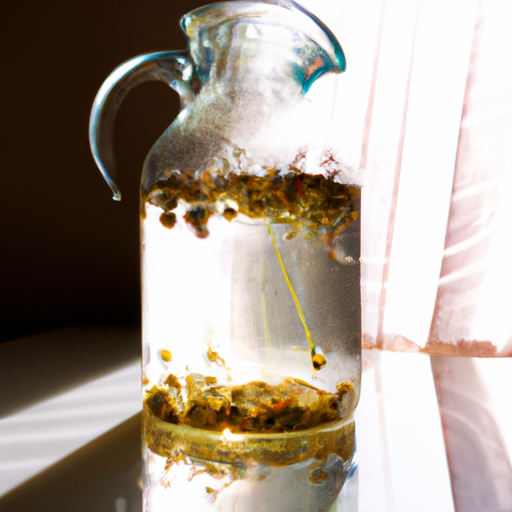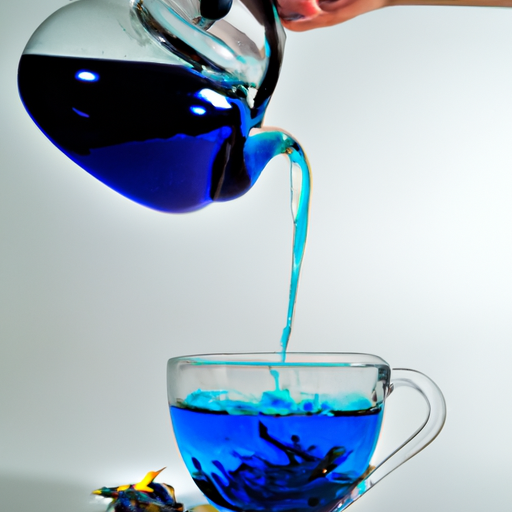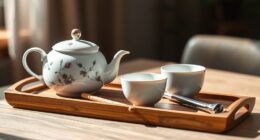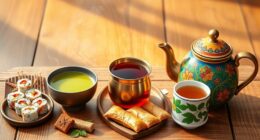Are you prepared to start a journey of delicious tastes and calming scents?
Picture this: after a long day at the office, all you desire is a moment of peace. What better way to relax than with a perfectly brewed cup of floral tea?
Imagine yourself in a peaceful garden, surrounded by vibrant flowers. Each sip of your meticulously steeped tea transports you to a world of serenity and relaxation. But how can you achieve this level of perfection? Fear not, for I am here to guide you on your quest to steep the most exquisite flower tea.
In this article, I will share with you my secrets to steeping flower tea. From choosing the right tea leaves to pouring hot water over them, I will walk you through each step with precision and passion.
By following my detailed instructions, you will be able to savor the true essence of flower tea and indulge in a moment of pure bliss. So, let’s dive in and discover the art of steeping flower tea together.
Get ready to awaken your senses and elevate your tea-drinking experience to new heights.
Key Takeaways
- The choice of flower tea impacts both the taste and the health benefits derived from the steeping process.
- It is important to use high-quality loose flower tea and to steep it using the appropriate method and water temperature for optimal flavor.
- The steeping time for flower tea depends on the type of flower and personal preference, with delicate flowers requiring less time than robust flowers.
- After steeping, the tea should be strained using a fine-mesh strainer or infuser, and can be served in delicate teacups, glass cups, or mugs.
Choose Your Flower Tea
Now it’s time for you to choose your favorite flower tea and indulge in its delightful flavors! There are so many different types of flower teas to try, each offering its own unique taste and benefits.
From the calming chamomile to the fragrant jasmine, there’s a flower tea for everyone’s preferences.
One popular flower tea is rose tea, known for its romantic aroma and subtle sweetness. Not only does rose tea taste amazing, but it also has numerous health benefits. It’s rich in antioxidants, helps improve digestion, and can even boost your immune system.
Another great option is hibiscus tea, which has a tart and tangy flavor. It’s packed with vitamin C and can help lower blood pressure and cholesterol levels.
No matter which flower tea you choose, you can enjoy the soothing and calming effects that come with each sip. Flower teas aren’t just delicious but also promote relaxation and overall well-being.
So, gather your supplies and get ready to steep your chosen flower tea.
Gather Your Supplies
To prepare flower tea, the first step is to ensure you have all the necessary supplies ready. Selecting the best tea leaves is crucial for a flavorful and aromatic tea experience. Look for high-quality loose flower tea, as it tends to have a more robust flavor compared to tea bags. You can choose from a variety of flowers such as chamomile, hibiscus, jasmine, or lavender, each offering unique flavors and health benefits.
Once you have your flower tea, it’s time to explore different brewing methods. One popular method is the traditional infusion method. Simply add a teaspoon of loose tea leaves to a cup or teapot, and then pour hot water over the leaves. Allow the tea to steep for about 3-5 minutes, or longer if you prefer a stronger flavor. Another method to try is the cold-brew method, where you steep the flower tea in cold water for several hours to extract a delicate and refreshing flavor.
Now, let’s transition to the next step: boiling fresh water. Remember, the quality of your water affects the taste of your tea. So, it’s essential to use fresh, filtered water to ensure a clean and pure taste in your flower tea.
Boil Fresh Water
Get ready to enhance your tea experience by boiling some fresh, filtered water that’ll infuse your senses with pure, tantalizing flavors.
When preparing flower tea, it’s crucial to pay attention to the water temperature as it directly affects the taste and aroma of the final brew. Follow these steps to ensure a perfect cup of flower tea:
-
Start by filling a kettle or pot with fresh, cold water. Use filtered water to remove any impurities that may alter the taste.
-
Place the kettle or pot on the stove and heat it over medium-high heat. Avoid using high heat as it may overheat the water and result in a bitter taste.
-
Keep an eye on the water and wait for it to come to a rolling boil. The bubbles should be vigorous and consistent.
-
Once the water reaches a rolling boil, turn off the heat and let it sit for a minute or two. This allows the water temperature to slightly decrease, as flower tea requires a lower temperature than black or green tea.
-
After the short rest, the water’s ready to be poured over your flower tea leaves or petals. The ideal temperature for steeping flower tea is around 180°F (82°C).
Now that the water’s ready, it’s time to preheat your tea pot or cup for the best tea experience.
Preheat Your Tea Pot or Cup
Ensure a warm welcome for your brewing masterpiece by preheating your tea pot or cup, like a cozy embrace on a chilly morning. Preheating is an essential step in steeping flower tea as it helps to maintain the optimal temperature for brewing and enhances the flavor profile of the tea. There are different methods you can use to preheat your tea pot or cup, each offering its own benefits.
One popular method is to pour hot water into the tea pot or cup and let it sit for a few minutes. This helps to warm up the vessel and remove any residual flavors or odors. Another method is to place the tea pot or cup in a warm water bath for a few minutes, which gently warms it up and ensures an even heat distribution. Alternatively, you can also preheat your tea pot or cup by rinsing it with hot water, ensuring that every inch of the vessel is warmed.
By preheating your tea pot or cup, you create an ideal environment for steeping flower tea, allowing the flavors and aromas to fully develop. With your vessel warm and ready, it’s time to move on to the next step: measuring the tea leaves.
Measure the Tea Leaves
Measuring the amount of tea leaves is crucial for achieving the perfect balance of flavors in your brew. Tea brewing techniques vary depending on the type of tea leaves you’re using and the desired strength of your infusion. It’s important to understand the different types of tea leaves and their flavors to make an informed decision when measuring.
For example, black tea leaves are typically stronger and require less quantity, while green tea leaves are more delicate and require a larger amount.
When measuring your tea leaves, it’s best to use a scale to ensure accuracy. Start by determining the recommended amount of tea leaves for the specific type of tea you’re brewing. This information can usually be found on the packaging or obtained from a trusted source. Once you have the recommended measurement, you can adjust it to your personal preference.
Experimenting with different quantities of tea leaves will allow you to find the perfect strength and flavor profile that suits your taste. Remember, the amount of tea leaves you use will also depend on the size of your teapot or cup.
Now that you’ve measured the tea leaves, it’s time to add them to the teapot or cup. Transitioning seamlessly into the next step, this will ensure a smooth brewing process without any interruption.
Add the Tea Leaves to the Teapot or Cup
Once you’ve determined the perfect amount of tea leaves, it’s time to add them to your teapot or cup to begin the brewing process. Did you know that the size of your teapot or cup can affect the intensity of the tea’s flavor? When adding the tea leaves, make sure to use a gentle hand to avoid crushing them, as this can release bitter flavors.
To make the most of your flower tea, consider using one of these steeping techniques:
-
Infuser: Place the tea leaves in a mesh infuser and submerge it in the water. This allows the flavors to infuse while keeping the leaves contained.
-
Teabags: If you prefer convenience, opt for pre-packaged teabags. Simply place the bag in your cup or teapot and add hot water.
-
Loose leaf: For a more immersive experience, use a tea strainer or filter to contain the loose leaves. This allows for greater control over the steeping time and intensity of the tea.
Regardless of the method you choose, be sure to follow the recommended steeping time for flower tea, as different varieties may require different brewing times.
Now that the tea leaves are added, it’s time to move on to the next step: pouring the hot water over the tea leaves. This will start the infusion process and bring out the full flavors of the flowers.
Pour the Hot Water over the Tea Leaves
Now it’s time to pour the hot water over your carefully prepared tea leaves, allowing the fragrant flavors to bloom and dance in your cup.
The temperature of the hot water plays a crucial role in extracting the perfect flavors from your flower tea. It’s recommended to use water that’s around 175°F to 195°F (79°C to 90°C) for most flower teas. However, some delicate varieties may require slightly lower temperatures to avoid scorching the leaves and bringing out bitter flavors.
When pouring the hot water, you can choose from different brewing methods depending on your preference and the type of tea leaves you’re using. For a traditional approach, slowly pour the hot water onto the tea leaves in a circular motion, allowing them to unfurl and release their essence gradually. This method is ideal for teas with large, tightly packed leaves. Alternatively, you can opt for a quick and efficient method by pouring the hot water directly onto the tea leaves and immediately draining the liquid into your cup. This method is suitable for teas with smaller leaves or flower petals.
As the hot water interacts with the tea leaves, it initiates a beautiful infusion process. This infusion process allows the tea leaves to release their flavors, aromas, and vibrant colors.
Once you’ve poured the water, it’s important to let the tea steep for the appropriate time, which we’ll discuss in the subsequent section. So, let’s move on to the next step and explore how long you should steep your flower tea to achieve the perfect cup of fragrant bliss.
Steep the Tea for the Appropriate Time
After pouring the hot water over the tea leaves, it’s essential to allow the infusion process to take place for the appropriate amount of time to achieve the perfect balance of flavors and aromas. The appropriate steeping time is influenced by various factors that can enhance or diminish the tea’s taste. Here are three key considerations to keep in mind:
-
Tea type: Each type of flower tea has its recommended steeping time. Delicate flowers like chamomile or lavender require a shorter steeping time of about 2-3 minutes, while robust flowers like rose or hibiscus can be steeped for 4-5 minutes for a more pronounced flavor.
-
Water temperature: The temperature of the water used affects the steeping time. For most flower teas, water between 175-195°F (80-90°C) works best. Steeping in water that’s too hot or too cold can result in a bitter or weak brew, respectively.
-
Personal preference: Ultimately, the steeping time should be adjusted according to personal taste preferences. If you prefer a stronger brew, you can extend the steeping time slightly, or if you prefer a lighter flavor, you can reduce it.
By understanding the appropriate steeping time and considering these factors, you can ensure a delightful cup of flower tea that’s bursting with flavors and aromas.
Now, let’s move on to the next section where we’ll discuss how to strain and serve the tea.
Strain and Serve
To fully savor the exquisite essence of your brew, it’s time to gracefully strain and present your aromatic creation. After steeping your flower tea for the appropriate time, it’s important to strain out the flowers and leaves before serving.
There are a few methods for straining tea, depending on your preference and the tools you have available.
One common method is to use a fine-mesh strainer or tea infuser. Simply pour the steeped tea through the strainer or place the infuser directly into your teacup. This method ensures that any loose leaves and petals are caught, leaving you with a smooth and clear tea.
Another option is to use a tea strainer or a teapot with a built-in strainer. These tools allow you to strain the tea directly into your teacup or teapot, removing any unwanted particles.
Once the tea is strained, it’s time to serve and enjoy. You can pour the tea into delicate teacups, adding a touch of elegance to your presentation. Alternatively, you can serve the tea in glass cups or mugs, allowing the beautiful colors and shapes of the flowers to be showcased.
Now that your tea is strained and beautifully presented, it’s time to sit back, relax, and enjoy your delightful cup of flower tea.
Enjoy Your Delightful Cup of Flower Tea
Sip and savor the delightful cup of flower tea, immersing yourself in the soothing aromas and exquisite flavors. As you take that first sip, you’ll be amazed at the numerous benefits flower tea brings to your health and well-being.
Here are four reasons why you should indulge in this floral infusion:
-
Boosts Immunity: Flower tea is packed with antioxidants that help strengthen your immune system, protecting you from common illnesses.
-
Promotes Relaxation: The calming properties of flower tea make it the perfect choice for unwinding after a long day. It helps reduce stress and anxiety, leaving you feeling refreshed and rejuvenated.
-
Enhances Digestion: Certain types of flower tea, like chamomile and lavender, have been known to aid digestion and relieve stomach discomfort. Say goodbye to bloating and indigestion!
-
Variety of Choices: From delicate rose petals to vibrant hibiscus blooms, there’s a wide range of flower teas to choose from. Each type offers its own unique flavor profile and health benefits, allowing you to explore and find your favorite.
Indulging in a cup of flower tea is more than just a beverage choice; it’s a way to nourish your body, mind, and soul. So go ahead, steep a cup and let the benefits of flower tea enchant you.
Frequently Asked Questions
Can I use any type of flower for making flower tea?
Yes, you can use various types of edible flowers to make flower tea. Not only does it add a touch of elegance to your teatime, but it also offers numerous health benefits.
Edible flowers such as chamomile, lavender, and hibiscus are popular choices. Chamomile promotes relaxation, lavender aids in reducing stress, and hibiscus is rich in antioxidants.
So go ahead and explore the world of flower tea, your taste buds and well-being will thank you.
How long should I preheat my tea pot before adding the tea leaves?
To achieve the perfect brew, it’s crucial to preheat your tea pot before adding the tea leaves. The preheating time depends on the type of tea pot you’re using, but generally, I recommend preheating for about 1-2 minutes.
This allows the tea pot to reach the optimal temperature, ensuring that the flavors and aromas of the tea leaves are fully extracted. A well-preheated tea pot sets the stage for a truly delightful tea experience.
Is it necessary to measure the tea leaves or can I just eyeball it?
When it comes to steeping flower tea, measuring the tea leaves is essential for achieving the perfect brew. While some may prefer to eyeball it, I highly recommend using a measuring tool to ensure consistency and balance in flavor.
By measuring the tea leaves, you can control the strength and intensity of the infusion, resulting in a more enjoyable and satisfying tea experience. So, don’t underestimate the importance of measuring your tea leaves for the best results.
Can I reuse the tea leaves for a second steeping?
Absolutely! You can reuse tea leaves for a second steeping, and it’s not only possible but also beneficial. The second steeping extracts different flavors, creating a unique experience. By allowing the leaves to fully unfurl during the first steeping, the second infusion reveals subtle and delicate flavors that were previously hidden. It’s like discovering a hidden treasure in each sip.
So go ahead and savor the rewards of reusing your tea leaves for a second steeping!
How long can I keep flower tea in the refrigerator before it goes bad?
To prolong the shelf life of flower tea, it’s important to store it properly in the refrigerator. The best temperature for storing flower tea is between 35-45°F (2-7°C). Keep the tea in an airtight container or sealed bag to prevent moisture and odors from affecting its flavor. Avoid exposing it to direct sunlight or strong odors in the fridge.
By following these guidelines, you can enjoy fresh and aromatic flower tea for a longer period of time.
Conclusion
After following these steps, I can confidently say that steeping flower tea is a delightful and rewarding experience. The aroma, flavors, and health benefits of flower tea are truly something to be cherished.
By selecting the right tea, using the proper equipment, and steeping for the appropriate time, you can create a cup of flower tea that will transport you to a world of relaxation and rejuvenation. So go ahead, dive into the world of flower tea and indulge in its magical properties. It’s time to treat yourself to a cup of pure bliss.

